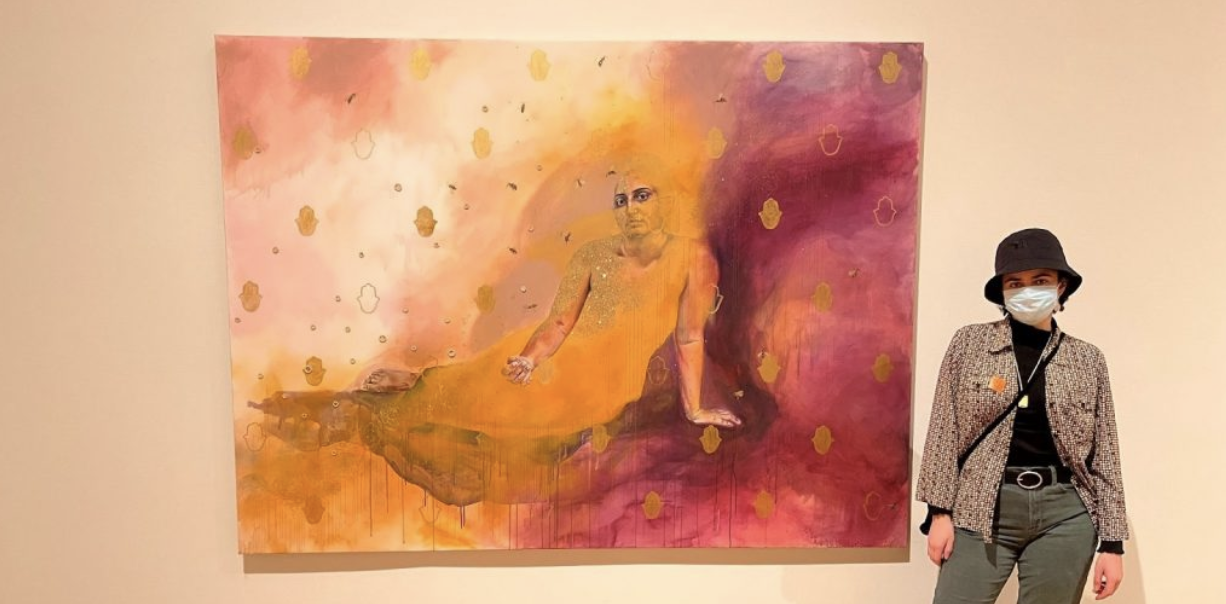

As awe enveloped my body, my eyes gravitated toward a painting in Saba Taj’s “there are gardens at the margins”, a mixed-media visual arts exhibition displayed at the Duke University Nasher Museum. In the first painting, a middle-aged person, whose figure is immersed in coral-colored smoke, steps into a mihrab-shaped portal into outer space. A rainbow outlines the portal, and a gold-glitter shadow in the same mihrab shape lies just behind. As the person steps into the portal, an Islamic geometric design in silver glitter illuminates on the person’s leg. As a whole, the painting exudes vibrance, applique, and color, precise in their patterns yet encloaked in mystery. My entire being resonated with the art– they capture the acceptance of uncertainty, fixation to detail, and chaotic exuberance I feel during my college years, especially as I continue to grow into myself, my relationship with others, and my relationship with Allah (SWT).
In the exhibition, Saba Taj, a queer Muslim themself, highlights queer Muslims in the American South. While the description of the paintings are not explicitly environmentalist, I knew they contained an environmental dimension that I could not quite articulate at the time. I was grateful to follow this idea through a Benenson Award: this summer, I explored environmental motifs in “there are gardens at the margins” through responsive interpretative poetry. To ground myself in the work, I first read through interviews with Saba Taj regarding “there are gardens at the margins” and conducted outside research on certain environmental, queer, and Muslim themes and motifs I found in the paintings. During the poetry process, I wrote based on my overall takeaways from the paintings, only to later pair each poem to a specific painting later on.
In particular, I focused on barzakh, a Qur’anic theme central to Taj’s paintings. Barzakh can be represented as the meeting between freshwater and saltwater, between the material and spiritual world, a rainbow between two clouds, or the duality of light as particles and waves. Saba Taj employed this concept as a symbol for how queer Muslims blur gender boundaries through their very existence. I felt inspired by this embracing of the messy contradiction of the world, finding peace and beauty in my inability to compartmentalize reality to my restrictive human logic.
This Benenson project is part of an honors thesis with the Duke International Comparative Studies Department on queer Muslim environmentalisms in the United States. My main questions for the thesis are as follows: (1) How do Muslim and queer environmentalisms connect? (2) How can the intersection of queer and Muslim perspectives shift Anglo-Western dominated environmental discourse? (3) How is this reflected in the lives and expressions of queer Muslims within the United States? I developed an interest in this topic after realizing that my identities as queer and Muslim greatly strengthened my commitment to the environment. My queerness and Muslimness motivate my search for an understanding of nature and the environment beyond Anglo-Western accounts, which are often dominated by capitalism, heteropatriarchy, and human exceptionalism. Although I have much more to explore, I find that putting queerness and Muslimness in dialogue could open new possibilities for understanding the environment.